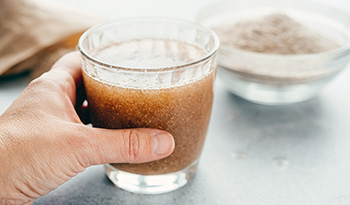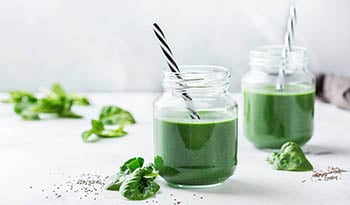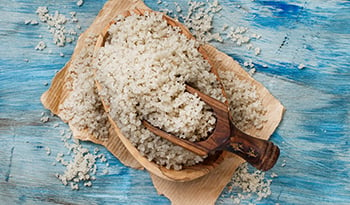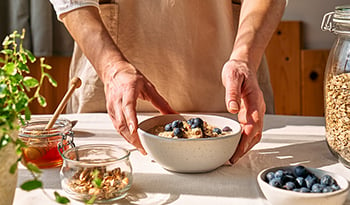The Best Foods To Increase GLP-1 Levels

What Does GLP-1 Do In The Body?
Around the globe, weight management using GLP-1 hormones is trending. There are a variety of products on the market with a target goal of regulating blood sugars while positively impacting weight. Many of these products mimic a natural hormone produced in the human body called Glucagon-like peptide-1 (GLP-1). This hormone is secreted by certain neurons in the brain and the intestinal enteroendocrine L-cells after food consumption.
Blood Sugar Regulation
GLP-1 plays an integral role in blood sugar regulation. It accomplishes this by stimulating the release of insulin and reducing the release of glucagon. Insulin lowers blood sugar levels by removing glucose from the blood and taking it to body tissues for energy and energy storage. Glucagon releases glucose from the liver when blood sugars are low, typically in a state of fasting, to raise blood sugar levels.
Slows Digestion and Increases Satiety
GLP-1 also slows digestion and contributes to a full sensation. It does this specifically by slowing the rate at which the stomach empties. This effect decreases appetite, which lessens food consumption. Improved blood sugar regulation and weight management can be a desired side effect of appetite suppression resulting in less food intake.
There are several ways to support GLP-1 hormone production naturally in the body. In particular, many foods are known to increase GLP-1 levels. Let us dive into these GLP-1-promoting foods that consequently help regulate your blood sugar and decrease your appetite. Together, they have a positive effect on weight management.
6 Foods That Support GLP-1 Secretion
Foods high in fiber, protein, and healthy fats have been proven to increase GLP-1 secretion in the gut. Nutrients such as fatty acids, monosaccharides, and peptides positively affect its secretion as well. The following foods are rich in these nutrients and are known to increase GLP-1 hormone levels.
1. Avocado
Rich in monounsaturated fats and fiber, avocados may improve GLP-1 levels. A study found that foods high in monounsaturated fats may stimulate GLP-1 secretion. Another study found that eating a whole avocado with a meal increased GLP-1 levels while also reducing insulin levels.
In addition to the healthy fats in avocados, they are also high in fiber. High fiber content in avocados helps to slow digestion and therefore slows the rate of glucose released by the pancreas into the bloodstream. This helps regulate blood sugar levels and may improve insulin resistance.
Slower digestion also leads to feelings of satiety and therefore decreased appetite. Slowed digestion also leads to a more gradual release of glucose into the bloodstream. This gradual glucose release in turn leads to increased GLP-1 secretion. This is a great benefit for a healthy weight management strategy.
Mashed avocado mixed with a bit of salt and lime juice as a healthy chip dip or spread over toast for a filling GLP-1 boosting treat.
2. Nuts
Rich in fiber, protein, and healthy fat, nuts such as pistachios, almonds, and walnuts may increase levels of GLP-1 secretion. Similar to avocado, the high fiber content in nuts helps to slow digestion and, therefore, slows insulin release, resulting in increased GLP-1 secretion.
Insulin sensitivity can also be helped with nut consumption thanks to their healthy fats. These recommended nuts help keep you full longer, leading to increased feelings of satiety with decreased appetite and calorie consumption.
A great way to add nuts into your diet is to enjoy a handful as a snack or add them to your favorite salad recipe for extra crunch.
3. Eggs
An ideal source of protein and monounsaturated fats, eggs, and especially egg whites, have been shown to increase GLP-1 secretion.
One study found that a meal with three eggs compared to a bagel breakfast resulted in lower blood sugar levels after the meal. In addition, reduced food intake and decreased feelings of hunger were reported by the study participants over the following 24 hours.
Try a vegetable omelet or a few boiled eggs to start your day by supporting optimal GLP-1 secretion.
4. Grains
High-fiber grains produce short-chain fatty acids (SCFA), including butyrate, acetate, and propionate, when fermented in the gut. SCFA may stimulate the release of GLP-1 by binding to the L-cell receptors.
Fiber in grains also helps to slow digestion, leading to the gradual release of glucose, triggering GLP-1 secretion.
Enjoy a bowl of oatmeal or whole wheat bread to start your day off supporting your GLP-1 hormone levels. Other whole grains such as barley, rye, millet, and buckwheat are also rich in soluble fiber, helping with satiety and GLP-1 secretion.
5. Olive Oil
Many studies have shown the benefits of a diet rich in olive oil on GLP-1 levels. One such study shows that diets rich in olive oil lead to higher GLP-1 levels postprandial, or after eating. The same study also showed that those consuming diets rich in olive oil have lower glucose levels both after eating and when fasting, along with improved insulin sensitivity.
Another study found that mice that regularly consume olive oil in their diets have increased GLP-1 secretion and improved glucose tolerance. When diabetic mice consumed a diet rich in monounsaturated fatty acids from olive oil, the study found they had decreased weight gain, improved insulin sensitivity, and increased GLP-1 levels.
Use olive oil to sauté your favorite veggies or as a drizzle on a salad or deli sandwich to reap the benefits of this GLP-1 superfood.
6. Vegetables
Asparagus, broccoli, artichokes, and celery are a few examples of fiber-rich vegetables that could help increase GLP-1 levels and may also help regulate blood sugar levels.
One study concluded that consuming vegetables before eating carbohydrates significantly impacts GLP-1 and glucose levels in type 2 diabetes patients. The biggest impact was seen 60 minutes after a meal.
Toss colorful vegetables in olive oil and sprinkle with sea salt before roasting them in an air fryer for a flavorful and nutritious side dish that supports healthy blood glucose and GLP-1 hormone levels.
Foods to Avoid
While high protein, high fiber, and healthy fat foods support the stimulation of GLP-1, other foods may negatively affect GLP-1 secretion.
High Sugar Foods
Both sugary beverages and sugary snacks should be avoided for optimal GLP-1 levels. Sodas and other sweet snacks like candy and cookies lead to rapid spikes in blood sugar levels which negatively impacts GLP-1 secretion. Unsweetened beverages, water, nuts, veggie sticks, and herbal teas are better options for not only glucose and GLP-1 levels but are also ideal for weight management.
Trans Fats
Store-bought baked goods and fried foods are high in trans fats. Trans fats impair insulin sensitivity and reduce GLP-1 secretion.
Opt for baked, sautéed, or air-fried foods for more optimal glucose and GLP-1 secretion levels. Consume home-baked goods from scratch and skip the unhealthy convenience of store-bought pastries.
Processed Foods
Unhealthy fats and refined carbohydrates are common ingredients in processed foods. Both of these unfavorable ingredients can disrupt GLP-1 production and dysregulate blood sugar levels.
Unprocessed, whole foods are the best option for good weight management practices. For example, a baked chicken breast and steamed carrots are a better lunch choice than a bologna sandwich and potato chips.
Alcohol
Moderate alcohol intake may not have a significant effect on GLP-1 levels, but excessive alcohol consumption can cause blood sugar imbalances and decrease GLP-1 production.
Limiting your alcohol intake is ideal for healthy blood sugar levels and optimal GLP-1 secretion.
The Big Picture
Research suggests that dietary modifications that support the body’s ability to naturally secrete GLP-1 could be an effective strategy for managing type 2 diabetes and obesity.
Foods high in protein, healthy fats, and fiber, such as eggs, whole grains, nuts, and vegetables, may support optimal GLP-1 levels. Healthy GLP-1 levels may aid in managing diabetes and promote feelings of fullness to help with overall weight management goals. By stimulating insulin release and inhibiting glucagon secretion, GLP-1 is an important hormone to support proper production and secretion for anyone looking to manage blood sugar levels or striving for a healthy weight. Considering GLP-1 is released in the intestine after eating, choose to consume the right foods that will trigger its release and avoid those that will negatively affect GLP-1 secretion.
References:
- Bodnaruc, A.M., Prud’homme, D., Blanchet, R. et al. Nutritional modulation of endogenous glucagon-like peptide-1 secretion: a review. Nutr Metab (Lond) 13, 92 (2016).
- Zhu L, Huang Y, Edirisinghe I, Park E, Burton-Freeman B. Using the Avocado to Test the Satiety Effects of a Fat-Fiber Combination in Place of Carbohydrate Energy in a Breakfast Meal in Overweight and Obese Men and Women: A Randomized Clinical Trial. Nutrients. 2019 Apr 26;11(5):952. doi: 10.3390/nu11050952. PMID: 31035472; PMCID: PMC6567160.
- Hira T, Trakooncharoenvit A, Taguchi H, Hara H. Improvement of Glucose Tolerance by Food Factors Having Glucagon-Like Peptide-1 Releasing Activity. Int J Mol Sci. 2021 Jun 21;22(12):6623. doi: 10.3390/ijms22126623. PMID: 34205659; PMCID: PMC8235588.
- Indarto, D., Rochmah, D. N., Wiboworini, B., Pratama, Y. M., & Wibowo, Y. C. (2022). Effects of Vegetables Consumption Before Carbohydrates on Blood Glucose and GLP-1 Levels Among Diabetic Patients in Indonesia. International journal of preventive medicine, 13, 144. https://doi.org/10.4103/ijpvm.IJPVM70420
ΑΠΟΠΟΙΗΣΗ ΕΥΘΥΝΗΣ:Αυτό το Κέντρο Ευεξίας δεν προορίζεται να παρέχει διάγνωση...
















































































 Πίνακας περιεχομένων
Πίνακας περιεχομένων















